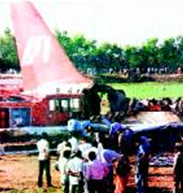Bangalore air crash :1990
(Created page with "{| class="wikitable" |- |colspan="0"|<div style="font-size:100%"> This is a collection of articles archived for the excellence of their content.<br/>You can help by converting...") |
m (Pdewan moved page Bangalore crash :1990 to Bangalore air crash :1990) |
Revision as of 19:14, 14 March 2014
This is a collection of articles archived for the excellence of their content. Readers will be able to edit existing articles and post new articles directly |
Bangalore crash :1990
REVISITING THE HORROR
Crash that shook Bangalore in 1990
Vinay Madhav | TNN
Bangalore: On a bright Valentine’s Day afternoon in 1990, an A-320 Boeing aircraft which had taken off from Mumbai at 11.58 am, started descending to HAL Airport in Bangalore. At 1.03 pm, the aircraft was on its final approach and descended well below the normal approach. It kept descending until it struck Karnataka Golf Club’s boundaries.
The aircraft, delivered to Indian Airlines in December 1989, was 2,300 ft short of the runway and 200 ft right of the extended centreline. It rolled for 80 feet and lifted off again for about 230 ft and came down on the golf course’s 17th green. The aircraft’s gears and engines sheared off as it continued to move before coming to a halt in nearby Challaghatta Lake’s marshy and rocky area.
It was Karnataka’s worst air crash and left 92 people dead, including four crew. Fifty-four passengers survived with injuries. The bodies were badly charred, forcing the police to go for a mass funeral.
One of the crash theories was that the pilot tried to use auto-landing system and misjudged the precise point of landing. Foreigners and VIPs, including three Birla family members, were among the victims and survivors. By the time rescuers reached the place, many survivors were walking away from the crash site.
Former IGP and then DCP, T Jayaprakash, who was at the airport to see off Bangalore police commissioner, recalls the harrowing day:
When we heard about the crash, the commissioner cancelled his Delhi meeting and without realising there was a wall separating the crash site and the airport, we set off on the runway. Once we hit the dead-end, we turned back and reached a jam-packed main road. Realising we would be stuck in the jam, we got out of the car and started walking. When we reached the site, we saw some survivors limping out of the water.
In 1990, wireless sets were the only means of communication and we roped in the entire Bangalore police force for the rescue. After moving the injured to hospitals, we recovered over 50 bodies and shifted them to Victoria H spital.
Since there were no facilities to preserve the bodies, the rule was that we couldn’t conduct post mortem till the relatives identified the bodies. Most relatives had to travel a long distance. By early next morning, the bodies started decomposing. We ordered for a large quantity of ice to help preserve the bodies. It helped for some time, but by afternoon, the ice melted and the bodies started swelling. By evening, we decided to have a mass funeral. We called for a priest, a maulvi and guru from the gurdwara. After a prayer for the departed souls, we held a mass funeral.
